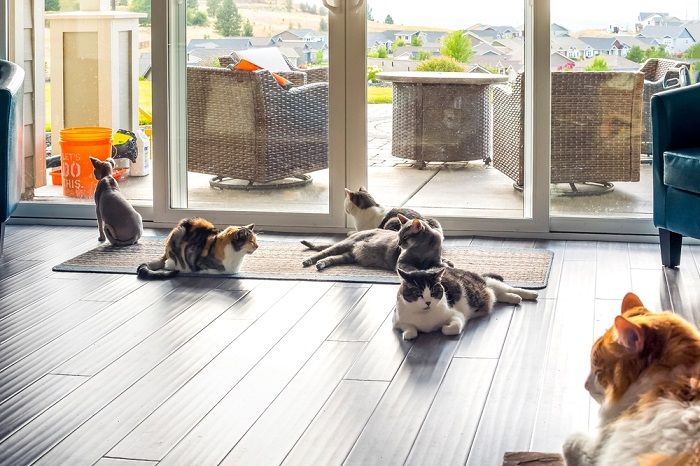
One of the big decisions cat owners have to make is which sex of cat to choose. If they decide they want more than one cat (which has many benefits), they then have to decide whether a male or a female companion would be better. This is a tricky decision and a lot does depend on the individual cats and their background.
Key Takeaways
Cats are very territorial, so if you have a single cat in your household, they can get upset if you bring in another cat.
Same-sex cats might be more prone to fighting to establish dominance, especially if they are not spayed or neutered.
It's possible to introduce two adult female cats, but they will need a lot of time and space to slowly get to know each other.
Is it better to have two female cats or a male and a female? Read on to discover if female cats get along and how to encourage peace in multi-cat households.
Does Your Cat Need A Female Friend?

Two female cats that grow up together usually get along well as adults.
Female cats are called queens and they certainly do live up to this regal name. Cats like to establish a hierarchy in their living environment. It’s important for them to know who is the “top cat.” If another queen is introduced into the household this can definitely put her nose out of joint! Some female cats will get on very well with another queen, but others might not and it can cause a great deal of friction.
This does depend on what your cat has been through in the past and if they are well socialized with other cats. Cats do live in larger groups in the wild. They have a close-knit community and treat every member as family, so historically they are primed to live in a social setting. The problems arise when your cat has been the only cat in the household and you suddenly introduce another female.
If you have two littermates that are both female or get two young kittens at the same time, chances are they will get along great because they will grow up together and be used to each other’s scent. There is no disruption to their routine or invasion of their private space when they start out together, so they nearly always get on swimmingly.
Also Read: 5 Ways To Build A Stronger Bond With Your Cat
Why Wouldn’t Two Females Get Along?

Some cats can live together in harmony but this is highly dependent on the cats’ individual personalities.
There are a few reasons female cats might not get along in the same house. If one or both of the cats were not socialized well with other cats and/or other pets, they will have had an absence of positive associations with other creatures, and they often react badly to newcomers as they feel like their territory is being invaded.
Single adult cats have never had to share their space before and it can be confusing and cause them to act defensively or aggressively. This is because they will feel threatened by the other cat. They will smell differently and make all the objects and people in the house smell differently, too.
Cats like to scent mark everything in their environment, so if there are two cats present they will be competing over a lot of things to rub their own scent and “claim” as their own. They even do this with us humans! It can get very competitive and can be a huge stressor for the cats.
Imagine going to snuggle up to your favorite human to find the smell of your new enemy—yuck! If you have two unrelated male or female cats, they do usually struggle to establish harmony in the house at first.
Another reason might be simply a difference in personality. Your cat’s temperament will dictate how accommodating they are toward other cats. A timid cat is likely to get bullied by a more commanding cat, as they will want to assert their dominance.
Also Read: How To Tell Which Cat Is Dominant
Queens of different ages will have different energy levels and take joy in different things. Some things might seem beyond exciting for one cat and mundane and boring for another. Sometimes this causes a clash with cats as one cat will get very fed up and frustrated with the other cat and end up reprimanding them or lashing out.
Some cats get along at first, but then something happens that makes them associate the other cat with something negative. For example, if one cat visits the vet for an operation, if the other cat dislikes the vet when they are reunited and the cat smells of the vet, the other cat might hiss and spit at the cat as they associate that smell with bad things.
Spaying and neutering can also have an effect on a group dynamic. Cats that have been spayed or neutered are much less affected by territorial aggression. Unspayed females are less likely to get along due to the pressure of competition finding a mate.
Spaying both cats will help. Spayed females won’t be as interested in fighting for the dominant spot. When cats are fixed they won’t be exposed to the effects of circulating sex hormones, although this is more relevant for male cats than females.
Also Read: How Much Does It Cost Spay or Neuter A Cat?
A queen that has recently given birth will not take kindly to other female cats, even if they did previously get along. This type of aggression is called maternal aggression. A postpartum queen may show various signs of aggression, including growls or attempting to bite or swat at the other cat.
This does usually subside when the kittens leave the mother but it is recommended to spay the mother if she shows signs of aggression so that she doesn’t pass bad traits on to her future offspring.
Also Read: 10 Causes Of Aggression In Cats And How To Help
How Do You Introduce Two Female Cats

First things first, you have to prepare the environment before you even think of letting another queen through the door. Here is a little equation for you (and don’t worry if math isn’t your strong point, it’s pretty simple): number of cats = number of resources.
This is a good rule to live by in multicast households. So basically if you are planning on having two cats, you need two beds, three litter trays (one for each cat, plus one more), two water bowls, two feeding bowls, two scratching posts, and two of each toy. You get the drift.
Next, you need to strategically spread these resources around the house so that each cat can eat, sleep, scratch, pee, and poop in complete solidarity, with all the privacy they need. Also, make sure you don’t put one cat’s feeding bowl near the other cat’s litter box.
Secondly, you can use something like a Feliway diffuser or similar alternative. This is a plug-in product that releases a scent that mimics the pheromones released by a nursing queen to calm and reassure her kittens when they are feeding.
Thirdly, take it very slowly. When you bring the new cat home, confine them to one room away from the other cat initially. Allow the cats to swap scents by putting a blanket from each cat in the other cat’s bed so they can sniff it and become accustomed to the new smell of the other cat. After a few days, swap food bowls between cats. (This is safe to do unless one of your cats is sick or on a special diet—in that case, skip this step.)
When they appear happy with the new scent, allow them to see each other. It’s best to still have a physical barrier between them initially, in case one of them lashes out and injures the other one. Either leaving one of them in the cat box or allowing them to see each other through a baby gate or screen door are good options.
Also Read: How To Introduce New Cats To A Home
Gradually allow the cats to get closer and closer until they are near enough for physical contact. Always supervise them and if either cat shows signs of aggression or anxiety, separate them again and go back a stage. It might take many months for the two cats to accept each other. It is important not to force things and to let them go at their own pace.
Lastly, don’t scold your cat if they show signs of conflict. This just adds more stress to an already stressful situation. Ensure both cats have a few places they can immediately escape to. Monitor both cats’ behavior, looking for any changes in their appetite, grooming, and their toileting habits as these can all be an indicator of an extremely stressed cat.
If you don’t feel you’re getting anywhere, you can seek advice from your veterinarian or a veterinary behaviorist for guidance. It is important to rule out any underlying medical issues as this will affect the cat’s behavior.
Also Read: What Are Cat Pheromones And Do They Really Work?
Female Cats: Final Thoughts

The best time to introduce cats of any sex is during kittenhood as the likelihood of them getting along as adults is high.
Female cats can and do get along, although it is very much dependent on a few important things. Litter mates generally get along, or two kittens from separate litters if introduced very young. Spayed females usually get long better than two unspayed females. Two adult females can live in harmony together, provided they are introduced properly and allowed to establish their own hierarchy.
It does also depend on their past experiences with other cats. If one cat is a more dominant cat and the other one is submissive, the dynamic can change. It is vital that both cats have their own space they can retreat to if they need it. If you follow this guide and have patience, there is a very good chance you will be able to have two female cats living happily together.
Also Read: Do Cats Get Lonely Without Other Cats?
Frequently asked questions
Are two female cats good together?
Introducing two adult female cats is not without its challenges. However, it does depend on the individuals. If you have an adult female it is possible to introduce another female but it will be a lengthy process as you will need to give them a lot of time and space to slowly get to know each other. It will be a smoother transition if both cats are neutered, too.
Is it better to have 2 female cats or 1 of each?
Same-sex cats might be more prone to fighting to establish dominance. However, providing you introduce the two cats properly, the sex doesn't make too much of a difference, especially if the cats have been neutered. Two littermates are ideal.
Do female cats like to live together?
In the wild, cats tend to live in large groups. They usually live with their relatives. Female cats help each other out with their young, so they benefit massively from living in social groups.







